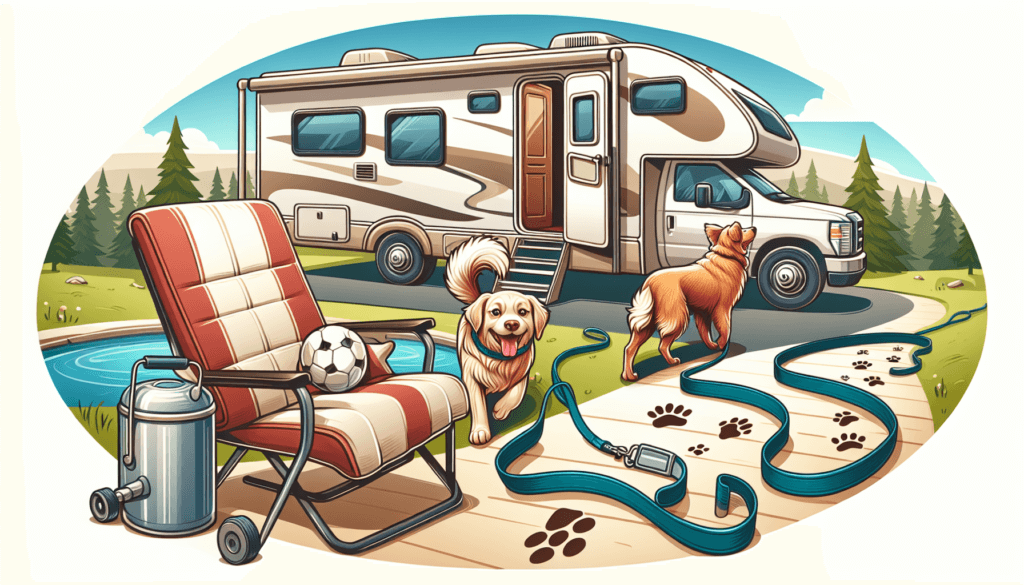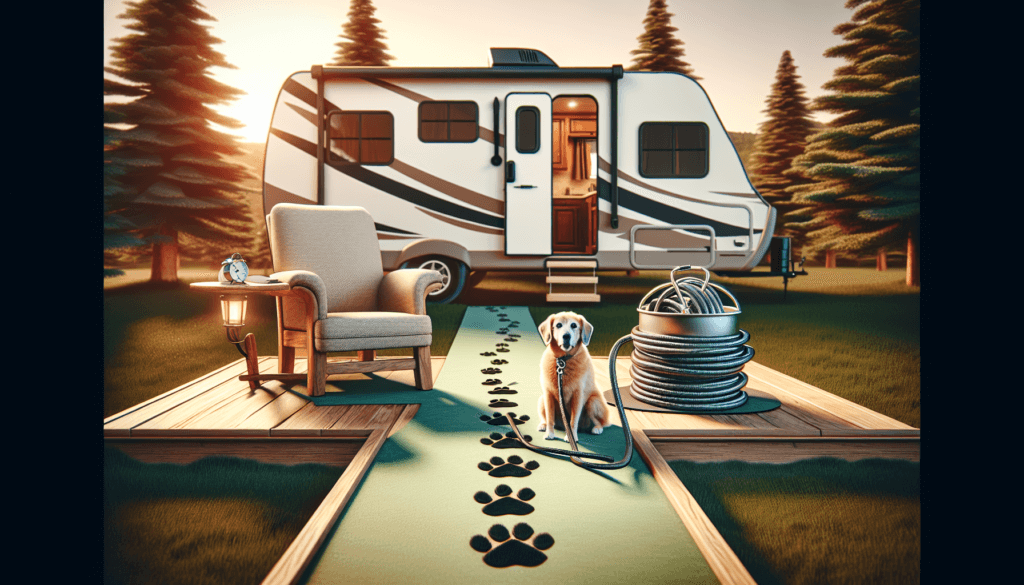Are you a proud dog owner who loves exploring the great outdoors? Look no further than RV camping with your furry friend for the perfect pet-friendly adventure! In this article, you’ll discover essential tips to ensure a smooth and enjoyable trip for both you and your canine companion. From choosing the right RV and planning pet-friendly activities to packing essentials for your pooch, we’ve got you covered. So grab your dog’s leash and get ready to embark on an unforgettable RV camping experience!
Planning for Your Trip
Choosing the Right RV
When planning a trip with your dog, it’s important to choose the right RV that will accommodate both you and your furry friend comfortably. Look for an RV with enough space for your dog to move around freely, as well as features like pet-friendly flooring and secure windows that will keep your dog safe. Consider the size and breed of your dog when selecting the RV, as larger dogs may require more space. Additionally, make sure the RV has proper ventilation to keep your dog cool and comfortable during the trip.
Finding Pet-Friendly Campgrounds
One of the key aspects of a successful trip with your dog is finding pet-friendly campgrounds. Before embarking on your journey, take the time to research and identify campgrounds that welcome dogs. Look for amenities such as designated dog walking areas, pet waste stations, and nearby hiking trails or beaches where you and your four-legged friend can enjoy outdoor activities together. It’s also important to check if the campground has any breed restrictions or specific rules regarding dogs.
Packing Essentials for Your Dog
When packing for your trip, don’t forget to pack the essentials for your dog too. Some must-have items include food and water bowls, a leash and collar, bedding, toys, and any medications or grooming supplies your dog may need. It’s also a good idea to bring along your dog’s favorite blanket or toy to provide comfort and familiarity during the trip. Additionally, packing a pet first aid kit is essential in case of any unexpected accidents or injuries along the way.
Preparing Your Dog for the Trip
Updating Vaccinations and ID Tags
Before hitting the road, ensure that your dog’s vaccinations are up to date. This is especially important if you plan on visiting different states or crossing borders during your trip. Vaccinations protect your dog from potential diseases and prevent the spread of infections. Additionally, make sure your dog’s ID tags are secure and display your current contact information. In case your dog gets lost during the trip, having updated ID tags will help facilitate a quick reunion.
Training and Socializing Your Dog
Traveling in an RV can be a new and potentially overwhelming experience for your dog. To make the trip more enjoyable for both of you, invest some time in training and socializing your dog beforehand. Teach basic commands such as sit, stay, and come, as these commands will come in handy during your journey. Socialize your dog with other animals and humans to help reduce any anxiety or aggression they may experience when encountering new environments or individuals.
Getting Your Dog Used to the RV
To ensure that your dog feels comfortable and at ease in the RV, gradually introduce them to this new environment. Start by allowing your dog to explore the RV while it is parked and stationary. Let them get familiar with the smells, sounds, and layout of the space. Then, take short trips in the RV to help your dog adjust to the motion and vibrations of travel. Provide positive reinforcement and rewards to create positive associations with the RV and make it an enjoyable experience for your furry friend.

Safety Measures for Traveling with Dogs
Securing the RV for Your Dog’s Safety
It’s crucial to secure the RV to create a safe environment for your dog during travel. Ensure that all cabinets and storage areas are properly closed to prevent items from falling and potentially injuring your dog. Use child-proof locks on any cabinets that contain hazardous substances such as cleaning supplies. Additionally, secure loose objects in the RV to prevent them from becoming projectiles in case of sudden stops or turns. Creating a secure environment will minimize the risk of accidents and injuries to your canine companion.
Using Restraints and Cages in the RV
To prevent your dog from wandering around the RV while you’re driving, consider using restraints or cages. Look for harnesses or seat belts specifically designed for dogs, which can be attached to the RV’s seat belts or secured to the seats. These restraints will keep your dog in place and minimize the chances of them being injured in the event of an accident or sudden movement. Alternatively, using a properly sized crate or carrier can also provide a safe and comfortable space for your dog during travel.
Keeping Your Dog Calm during Travel
Some dogs may experience anxiety or stress while traveling in an RV. To help keep them calm and relaxed, provide a comfortable and familiar space for your dog in the RV. Use their favorite blanket or bed to create a cozy spot where they can rest. Consider playing calming music or using natural calming aids such as lavender oil to create a soothing atmosphere. Additionally, keep a supply of their favorite treats or toys handy to distract and entertain them during the journey.
Feeding and Hydration
Planning Your Dog’s Meals and Water
When planning your trip, it’s important to consider your dog’s dietary needs. Ensure that you have enough food for the duration of your trip, taking into account any necessary adjustments due to increased activity levels. Divide the food into portioned servings to make feeding convenient while on the road. As for water, always carry an ample supply and offer regular opportunities for your dog to drink to prevent dehydration.
Choosing the Right Dog Food for Traveling
Selecting the appropriate dog food for traveling is crucial to support your dog’s health and well-being during the trip. Opt for high-quality dog food that provides balanced nutrition to sustain their energy levels. Consider lightweight, easily portable options such as dry kibble or pre-packaged wet food. It’s also wise to avoid sudden dietary changes to prevent stomach upset. If your dog has specific dietary needs or allergies, consult with your veterinarian to choose the most suitable food for your pet’s individual requirements.
Managing Your Dog’s Bathroom Needs
When traveling with a dog, it’s essential to manage their bathroom needs effectively. Take regular bathroom breaks, allowing your dog to relieve themselves in designated areas. Be prepared with poop bags to clean up after your dog and dispose of waste properly. It’s important to respect campgrounds and trails by following their specific rules regarding pet waste. Additionally, be mindful of your dog’s bathroom habits and adjust feeding schedules accordingly to prevent accidents inside the RV.

Exercise and Entertainment
Creating a Comfortable Space for Your Dog
Designate a comfortable space inside the RV where your dog can relax and feel secure. Set up their bed or blanket, along with their favorite toys, to keep them entertained. Consider bringing familiar scents, such as an unwashed item of clothing, to create a sense of familiarity. Creating a cozy and familiar space will help your dog feel safe and content during the trip.
Taking Regular Breaks for Exercise
Exercise is just as important for your dog’s well-being as it is for yours. Plan regular breaks to allow your dog to stretch their legs and burn off energy. Research nearby hiking trails, beaches, or dog parks where you can take your dog for a walk or playtime. During breaks, ensure that your dog remains on a leash for their safety and the safety of others. Adequate exercise will not only keep your dog physically fit but also help alleviate any restlessness or pent-up energy.
Providing Mental Stimulation for Your Dog
In addition to physical exercise, mental stimulation is vital for your dog’s happiness and mental well-being. Bring along interactive toys or puzzle games that challenge your dog’s mind. Kong toys filled with treats can provide hours of entertainment and mental stimulation for your furry friend. Engaging your dog’s brain will help keep them entertained and prevent boredom during long stretches of travel.
Managing Your Dog’s Behavior
Setting Rules and Boundaries in the RV
Establishing clear rules and boundaries from the beginning will help create a harmonious environment in the RV. Determine where your dog is allowed and not allowed to go within the RV. For example, you may want to restrict access to the driver’s area to prevent distractions while driving. Consistently reinforce these rules through positive reinforcement, rewards, and redirection. By setting boundaries, you can ensure that your dog feels secure and understands their role during the trip.
Dealing with Anxiety or Aggression
Some dogs may experience anxiety or become aggressive in unfamiliar environments or during travel. If your dog shows signs of anxiety or aggression, it’s important to address these issues before embarking on your trip. Consult with a professional dog trainer or behaviorist to help you develop effective strategies to manage and alleviate these behaviors. Training and desensitization exercises can go a long way in helping your dog feel more comfortable and relaxed during the journey.
Addressing Travel-Related Issues
Traveling can sometimes bring about specific challenges for dogs. Motion sickness is not uncommon, especially for dogs who are new to RV travel. If your dog experiences motion sickness, consult with your veterinarian who may recommend medications or other remedies to alleviate their symptoms. Additionally, dogs may become startled by loud noises such as heavy traffic or the RV’s engine. Gradual exposure to these sounds in a controlled environment can help desensitize your dog and make them more at ease during travel.

Exploring the Outdoors with Your Dog
Choosing Dog-Friendly Activities and Destinations
When exploring the great outdoors with your dog, choose activities and destinations that are dog-friendly. Look for hiking trails, beaches, or nature preserves that allow dogs on leash. Research any specific restrictions or regulations for dogs in the area you plan to visit. Always prioritize the safety and well-being of your dog and respect any rules or guidelines set by authorities to protect the environment and wildlife.
Leashing and Monitoring Your Dog
To ensure the safety of your dog and the people and animals around you, always keep your dog on a leash. Even if your dog is well-behaved and obedient, it’s important to be mindful of other individuals and wildlife that may be present. Keep a close eye on your dog, especially in areas with potential hazards such as cliffs, steep terrain, or bodies of water. By leashing and monitoring your dog, you can have peace of mind and enjoy exploring the outdoors together.
Protecting Your Dog from Wildlife and Hazards
When venturing into the wilderness, it’s essential to protect your dog from wildlife and potential hazards. Keep a safe distance from wild animals, as encounters can be dangerous for both your dog and the wildlife. Be cautious of poisonous plants or toxic substances that your dog may encounter during your outdoor activities. Additionally, be mindful of extreme weather conditions, such as heat or cold, and adjust your plans accordingly to ensure the safety and well-being of your furry companion.
Health and First Aid
Maintaining Your Dog’s Health on the Trip
Keeping your dog healthy during your RV trip is a top priority. Make sure to bring any necessary medications that your dog needs and administer them as prescribed. Carry flea and tick prevention products and check your dog regularly for any signs of parasites. Regularly inspect your dog’s ears, paws, and coat for any cuts, bruises, or irritations. Maintain your dog’s grooming routine, including brushing their fur and cleaning their teeth. By staying proactive in caring for your dog’s health, you can prevent potential issues before they become more significant concerns.
Packaging a First Aid Kit for Your Dog
Having a well-stocked first aid kit for your dog is essential in case of any injuries or emergencies. Your first aid kit should include items such as bandages, antiseptic wipes, hydrogen peroxide, tweezers, and a thermometer. Additionally, pack any specific medications your dog may require, as well as their medical records and vet contact information. Familiarize yourself with basic pet first aid procedures and consult with your veterinarian on how to handle specific situations. A comprehensive first aid kit will give you peace of mind knowing you can provide immediate care if needed.
Recognizing Signs of Illness or Injury
While on your RV trip, it’s important to be vigilant and attentive to any signs of illness or injury in your dog. Watch for changes in their behavior, appetite, or energy levels. Keep an eye out for vomiting, diarrhea, excessive panting, or any unusual symptoms. If you notice any concerning signs, reach out to a veterinarian for guidance or seek medical attention if necessary. Recognizing early signs of illness or injury and taking prompt action can prevent further complications and ensure your dog receives the care they need.

Etiquette and Considerations
Respecting Campground Rules and Regulations
When staying at campgrounds, it’s essential to respect and adhere to their rules and regulations. Follow any specific guidelines regarding pet-friendly areas, leash policies, and waste disposal. Keep your dog from barking excessively, as this can disturb other campers. Properly dispose of pet waste in designated areas and ensure the campground remains clean and enjoyable for everyone. Respecting campground rules shows responsible ownership and contributes to a positive experience for everyone.
Being a Responsible Dog Owner
Being a responsible dog owner goes beyond simply following campground rules. Always keep your dog under control and supervise them at all times. Properly leash and restrain your dog when necessary, and keep them from approaching strangers or other dogs without permission. Be aware of your dog’s behavior and intervene if necessary to prevent any conflicts or potential danger. Being responsible and considerate of others will help maintain a harmonious camping experience for everyone involved.
Cleaning up After Your Dog
Cleaning up after your dog is not only vital for maintaining a clean and sanitary campground but also for preserving the natural environment and wildlife habitats. Always carry poop bags with you and promptly clean up after your dog. Dispose of waste in designated trash receptacles and avoid leaving bags on trails or in nature. By taking responsibility for your dog’s waste, you contribute to the preservation and cleanliness of the areas you visit, ensuring that they remain enjoyable for future visitors.
Finding Resources and Support
Researching Pet-Friendly RV Parks and Trails
Before embarking on your trip, take the time to research pet-friendly RV parks and trails along your planned route. Make a list of potential stops and gather information on their amenities, pet policies, and nearby attractions. Check online resources, such as pet-friendly travel websites or RV forums, to find recommendations and reviews from fellow pet owners. Being well-informed about pet-friendly options will help you plan an enjoyable journey that caters to the needs and interests of both you and your dog.
Connecting with Other Pet Owners
Joining online communities or forums for pet owners can be a valuable resource when planning and embarking on your RV trip. These platforms provide an opportunity to connect with other pet owners who have traveled with their dogs and can offer advice, tips, and recommendations based on their experiences. You can gain insights into pet-friendly destinations, campground recommendations, and even build friendships with like-minded individuals. Sharing and exchanging information with other pet owners can enhance the overall experience of your trip.
Seeking Veterinary Assistance if Needed
While on your RV trip, unforeseen circumstances may arise that require veterinary assistance. It’s crucial to have a plan in place in case your dog needs medical attention. Before departing, research veterinary clinics or animal hospitals along your route and keep their contact information readily available. In the event of an emergency, knowing where to turn for immediate veterinary care will help you address your dog’s needs promptly and effectively. Additionally, having access to veterinary support can provide peace of mind and alleviate any worries about your dog’s well-being during the trip.
In conclusion, planning and preparing for an RV trip with your dog requires careful consideration of their needs and well-being. By selecting a suitable RV, finding pet-friendly campgrounds, and packing essentials for your dog, you can set the stage for a successful trip. Preparing your dog for the journey through updating vaccinations, training, and acclimating them to the RV ensures a more comfortable and enjoyable experience. Implementing safety measures, managing feeding and hydration, providing exercise and entertainment, and addressing behavior management are crucial for a positive trip. Exploring the outdoors responsibly, prioritizing your dog’s health and first aid, and maintaining proper etiquette and cleanliness contribute to a harmonious journey. Lastly, researching pet-friendly resources, connecting with other pet owners, and having access to veterinary assistance if needed ensure a well-supported and rewarding RV trip with your furry companion. With proper planning and execution, your dog can be an enthusiastic and cherished travel companion as you embark on unforgettable adventures together.



